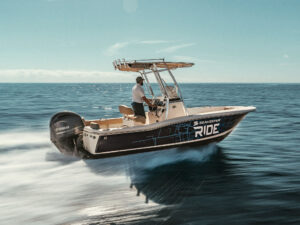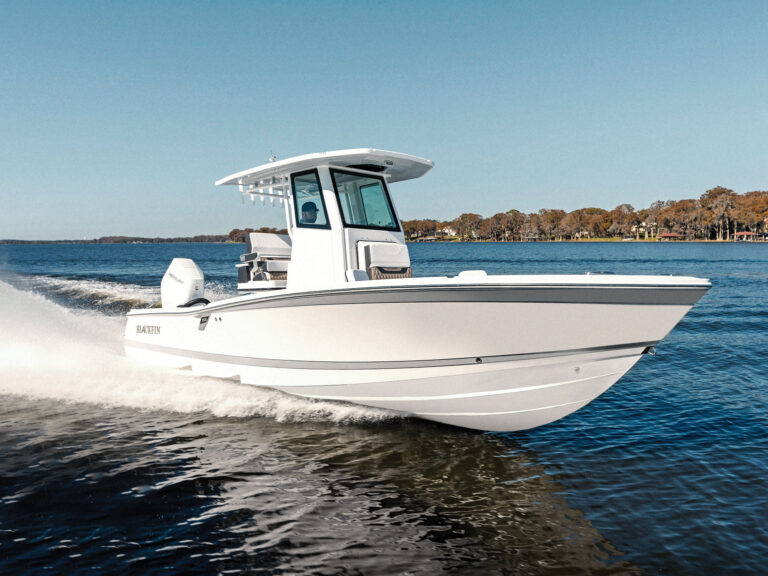Pick any coast, it doesn’t matter. From Catalina to the Gulf rigs or Middle Grounds, to the Bahamas, Cuba or the mid-Atlantic canyons, with settled summer weather and long days, the horizon beckons.
Optimizing your boat for comfort should be the first step in prepping for an extended trip. Two savvy offshore pros shared the tricks and the gear that keep their crews comfortable when the going gets long.

Balancing Act
Capt. Frank Crescitelli of New York City is a TV show host, charter captain and tournament angler who runs a 28 Buddy Davis center console. He loads up to 500 pounds of ice into the forward fish box to help keep the bow down.
Gear storage is another consideration. Crescitelli added Dubro rod racks to store heavy tackle forward for better weight distribution. “If you have four Penn 50s with line on gimbal-butt rods, you’d be surprised how fast that weight adds up,” he explains. In addition, he typically loads all tackle bags and extra gear inside the console but warns about a possible complication: “If you have metal in the bags, it could throw off the electronic compass sensor if it’s mounted in the console or under the helm.”
Marcus Kennedy of Mobile, Alabama, a longtime tournament player on the Southern Kingfish Association tour and the Gulf big-game circuit, runs a 39 Yellowfin center console rigged with triple Yamaha 350s and, like Crescitelli, he keeps up to 400 pounds of ice in his forward fish boxes to balance the load. He also mounts his boat batteries under the helm seat or inside the console for additional compensation.
“Some builders put the batteries in racks in the stern or bilge, but that’s just adding unnecessary weight aft,” he says. “If you have several batteries, at 60 to 70 pounds apiece, that’s a lot of weight that can be shifted forward.”
Fuel management is another way to improve the ride. Crescitelli burns his saddle tanks first and holds the forward auxiliary tank in reserve. That keeps the extra weight forward of the boat’s center of gravity until it’s needed. One gallon of gas weighs 6.1 pounds, so strategically locating that load definitely impacts the ride.
Attitude Adjustment
Hull design and construction also affect how soft a boat rides. “There’s no substitute for rigidity and the optimal running attitude,” Kennedy says. “There’s a trade-off in building ultralight. Sure, you add speed, but go too light and you lose handling and rough-water performance.” Kennedy adds that stepped hulls generally run level at cruising speeds, even with a couple of former college football linemen in the cockpit.
“Trim tabs are critical, especially on deep-V hulls,” Crescitelli says. “Tabs allow you to put the bow down and just let the dog eat. So when we’re in sloppy seas, and everyone gets behind the weather curtains, you can make adjustments on the go with the touch of button.”
Kennedy shared a neat trick for anyone who still has trouble keeping the bow down: “You can always put some sandbags in the forward hatches.”
Portable Lounge
“I’ve been using beanbags for years, but the updated designs and construction are really the ticket,” Kennedy says. “The chair shapes with contoured armrests really make them more comfortable. Ocean-Tamer and E-Searider are quality products with marine-grade vinyl that lasts longer and doesn’t mildew easily. I carry enough for everyone on the boat.”
Crescitelli prefers E-Searider bags, which come in different shapes and sizes. “My friends in Louisiana call them the redneck salon. They’re very comfortable. I’ve tried the inflatable ones, but you just bounce around too much in those.”
Cushy Footing
There’s still another accessory to keep in mind, says Crescitelli. “I’ve used anti-fatigue mats, and they really help lessen the bumps.”
Kennedy agrees. “I keep the Blue Marlin Chronicles anti-fatigue mat at the helm. It considerably reduces the shock coming off a big wave. It’s a solid 2 inches thick and has rounded edges that suck down and stay put.
“And don’t underestimate the role of a good pair of boat shoes,” he adds. “They cushion the ride too.”
So before your next trip 60 miles offshore, take a good look at the various options available to soften the ride. Give your back and knees a well-deserved break, and you won’t need to see your chiropractor.
Ways to Make Your Boat More Comfortable

Full Icebox: Fill the forward fish box with ice to balance the weight and keep the bow down.
Front Load: Storing heavy tackle in forward compartments also helps to flatten the running angle.
Cushy Footing: An anti-fatigue mat at the helm reduces fatigue and lessens stress on the knees and back.
Battery Center: Placing all batteries near the hull’s center of gravity aids proper weight distribution.
Deluxe Seating: Marine beanbag chairs carry the crew in comfort in the aft cockpit.
Following Laws of Travel By Boat
Trips to the islands or neighboring states are often the reason for long runs offshore, so it’s prudent to be in full compliance with the various laws. The applicable fishery agencies and customs websites provide current rules to help avoid problems.
The entire crew must have valid passports and clear customs and immigration prior to any fishing when crossing to the Bahamas or Cuba. A Bahamas cruising and fishing permit is required, and costs are based on vessel size and trip length. Get a copy of the latest fishing regulations and follow them to the letter, as they may be more restrictive than U.S. laws. Pay special attention to all bag, size and possession limits, especially when transiting. Visit bahamas.gov.bs for complete information.
If you cross into adjacent state waters, nonresident fishing licenses are required. Things can get a little confusing when a boat remains in federal waters, due to the lack of uniformity between states.
“Some states allow continuous transit, but others don’t,” says Maj. Grant Burton of Florida’s Fish and Wildlife Conservation Commission. “If you don’t make a stop on the way back in through state waters, you can go from Pensacola to fish in federal waters off Louisiana without another state’s license. Fishing gear must be stowed while underway, and the burden of proof of compliance is on the boaters.” Burton suggests signing up on myfwc.com for text or email alerts on changes to existing fisheries rules, such as closures. Anglers are also urged to sign up for the free Gulf Reef Fish Angler permit to aid in data collection.









